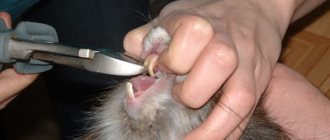Every rat owner sooner or later thinks about non-verbal ways of communicating with his pet. After all, understanding the body language with which an animal talks about itself is important for establishing contact with it and training.
We will find out what methods of communication rats use to transmit information to humans, we will analyze the basic gestures and sounds and their meanings.
What does a domestic rat look like?
The appearance of the domestic rat has not undergone major changes compared to its wild relatives. Most animals have an elongated, stocky body and a long hairless tail covered with sparse bristles. The size of the animal can be from 8 to 30 cm, and its weight can be up to 400-500 g. The elongated head is crowned with round ears, the eyes are small and bulging. The jaw of rats consists of 4 front incisors and molars. Different breeds of decorative rats differ in the structure of their fur:
- smooth;
- thin and shiny;
- curly;
- downy
There are animals without hair, for example, sphinxes and rodents with mixed coats. Colors can be plain or mixed. From gray and brown to orange and blue.
The bald sphinx is a type of rat.
In Dumbo rats, the ears “sit” not on the top of the head, but lower, like those of elephants. As a result of the mutation, rats were born with no tail at all.
Do pet rats smell?
The natural smell of the animal is not too strong; the main aromas come from excrement. It is commonly believed that sexually mature males stink, but this is not true. Despite the fact that males mark their territory by leaving odorous trails, some females can easily “outdo” them. It all depends on the character of the pet. There are clean boys who choose a certain corner to perform natural necessities and careless girls who “write down” hammocks and cage bars. The aromas in the cage of decorative rats depend on: the size of the room, the “population density”, the quality of the bedding, and most importantly, the frequency of cleaning.
Rats themselves have almost no smell
You need to clean your pet rat's cage at least once a week. Every day you should wipe down the shelves, change the water and wash the wet food bowls. It is better to remove the “signed” filler immediately or do it at least once a day.
Important! Rats should not be given pine litter!
Hammocks used as toilets should be washed 2-3 times a week.
If some family members do not like the pet, then they will always smell the animal
It is almost impossible to completely get rid of the smell in a room, but it is so mild that pet owners often do not notice it. Strong aromas can be washed off with laundry or baby soap, soda, and shampoos for rodents. The soap solution must be thoroughly rinsed with hot water.
Important! Rats are sensitive to strong odors.
Moustache wiggling
Rat whiskers are sensitive antennas that help animals navigate in space. The information that rodents receive with the help of such a navigator is so detailed that the animals not only move confidently in the dark, but also receive an almost complete understanding of the surrounding objects, including the features of their dynamic trajectory.
When a rat moves its whiskers, it not only explores odors, collects information about the world around it, but also maintains the balance of movement. It is with its sensitive whiskers that the animal first of all checks unfamiliar objects, including the palms of people.
Do pet rats bite?
They bite, but extremely rarely. There are a number of cases when a rat can bite:
- fright;
- pain;
- error. The animal tastes everything, so a finger inserted through the bars can be perceived as food;
- transitional age in males. From 5 months, males can bite in an attempt to dominate;
- female pregnancy. A pregnant and lactating female is able to claw, protecting the offspring.
Rats bite rather than bite.
In almost all cases, the owner is to blame. Mild biting by animals is a form of communication. The pet is trying to attract the attention of its adored owner.
Important! Physical punishment for a bite is the biggest mistake: a rat may lose trust in a person.
In the case of dominance, you can either turn the “impudent” guy onto his back and hold him in that position or sprinkle him with water. Usually it is enough to drive the pet away from you or stop playing with it.
What can you play with a rat at home?
The games you play with your rat are limited only by your imagination. If a particular game scares your pet or makes him nervous, try a different game. Feel free to use tiny treats to encourage the animal to stay put or do something. Use only rat-safe treats and only in small quantities so that your friend does not refuse his food afterwards. Some rats like some games and others don't. Pay attention to your pet's reaction. You can choose from the following games:
- A game of chasing and fighting.
Many may be surprised to learn that in nature, rats can also act as predators. In the wild, they chase and sometimes kill small animals in their territory. This means that rats love the chase.
With calm rats, you can play chasing with your fingers or wrestling. In this simple game, you have to get the rat's attention by scratching it with your fingers, and then try to provoke a light fight. Gently push, grab and turn the rat over, or pretend your hand is another rat. This is a great way to help your pet work off excess energy. Don't forget to let your pet win from time to time! Always let your rat decide how much he wants to play.
For variety, or if your rats are too busy with their fingers, many animals will enjoy a game of chase with a feather or cat stick instead. However, don't expect a toy like this to have a long lifespan.
- Make a labyrinth.
Rats are smart enough to solve mazes, and they like to run through tunnels to see where they lead. A great game is to create a maze of paths and tunnels on the floor or bed and encourage your rats to explore it.
Mazes can be made from cardboard, a drainpipe (make sure it's clean and big enough for rats), or fabric tunnels for small animals. They are really handy as they often have holes and Velcro so they can be bent into tees and loops. You can hide treats in mazes to reward your rats for exploring.
- Peekaboo.
Place the rat directly in front of you on the floor or table and quickly hide. When you suddenly reappear, your pet will be running around excitedly. Change the hiding place from time to time so that the animal tries to find you. If your rat becomes interested in the game, he may even try to find you on his own.
Hide and seek is a fun and easy way to interact with your rat at any time, whether he is in or out of his cage.
How to grind a rat's teeth
Healthy young rats wear down their teeth on their own using solid food and unsalted mineral stone. If you give your rodent a lot of soft food, it may ignore dry food. Not all animals like mineral stones. Some people love crayons, while others ignore these things altogether. “Whims” need to choose hard objects to taste:
- walnuts, hazelnuts or pine nuts;
- branches of fruit trees;
- special sticks from a pet store;
- boiled chicken bones;
- unsweetened crackers or crackers.
Incisors grow throughout their lives.
You can give your rat a cuttlefish shell or dry dog food to grind down its teeth. If the incisors have grown and the rat is starving, immediately run to the doctor. He will cut his teeth, and the animal will be healthy. You can do this operation yourself, but trust your veterinarian the first time.
How to play with baby rats
Rats are usually shy and do not like intense play. You can try hiding treats for your little rats to find. Place small pieces of food in pockets or folds of clothing and let your rat search for them. This will not only entertain the pet, but will also arouse the rat's affection and love for its owner.
Fruits and vegetables such as peas, carrots, potatoes, zucchini, strawberries, grapes and apples, as well as whole nuts and seeds, are excellent treats for pet rats.
You can also use strips of colored paper or small shiny objects to entertain your baby rats if you have already fed them during the day.
Why does the rat chew the cage?
By nature, a rat is supposed to chew everything in its path. The cell is no exception. Many pets do this at night, preventing them from falling asleep. Experience shows that for the animal this is more entertainment than an attempt to grind down its incisors. Rats chew the cage out of boredom if there is only one animal in it.
Most often, nervous animals engage in such things, but even completely healthy individuals will not deny themselves such pleasure. It is almost impossible to stop a rat from chewing its cage, but there are some things you can try:
- place a mineral stone, a twig, a piece of wood or a cracker in the cage before going to bed;
- cover your favorite “gnawing” spot with a mineral stone and hang branches between the bars;
- Move the cage to other objects with animals so that the animal does not get bored.
You should get several same-sex rats, then they will be busy with their relationships and, perhaps, will not touch the bars.
Bites
Experienced breeders of decorative rodents know that you need to thoroughly wash your hands when interacting with animals. Rats are unusually sensitive to odors. They may mistake a hand that smells like food for the food itself and grab it tightly with their teeth.
If an animal slightly bites its owner, ruffles its hair, and quietly clicks, it means that the animal is in a good-natured mood and invites you to play. A rat that has adopted an aggressive posture may bite for real if you do not give it time to recover.
When a fight brews in a cage, bites are also inevitable. Therefore, when handling an animal that is experiencing stress, you need to wear thick gloves.
How rats fight
You can tell whether rats are fighting or playing by the consequences. If it comes to blood and torn hair, this is a fight, emotional screams and throwing opponents on the floor - rather the establishment of a hierarchy. In a rat pack there are always masters and subordinates; dominance in behavior can be expressed in the form of bites. Real rat fights can occur among males if there is not enough space in the cage. Showdowns begin from 4-5 months until all roles are distributed. If hormones have a fatal effect, animals can be boarded or castrated.
Fight or play
What to do if rats fight until a girl bleeds
For beginner dog breeders
Aquarium equipment
What to do if decorative rats fight among themselves
Rats are social animals, so they feel better when living with other members of the pack. This is especially true when their owner cannot devote much time to them to communicate. In addition, they do not live long, and lovers of these rodents sooner or later begin to add a new young individual to the “old-timer”. Sometimes owners are frightened by the fussing and squeaking coming from a cage with several pets, and it is difficult for them to understand whether the rats are fighting or this is a game. The article will tell you why rats can fight and how to recognize their aggression towards each other.
Is it possible to place a baby rat with an adult rat?
Baby rats up to 2 months old can be placed with both males and females, but there are some nuances. Males will most likely accept the baby well, but problems will begin upon reaching adulthood. Adult males must build a hierarchy of relationships among themselves, and young rats are no exception. In the case of ladies, difficulties will arise when placing a baby rat with an adult rat. “Girls” don’t like strangers, even if they are kids. We'll have to wait until the children are saturated with the smell of the old-timers. When the adopted children “receive official registration” from mature ladies, then everything will be calm.
If you need to place a baby with a lonely rat, then it is better to have two
When the old rat passes into another world, the owner will not be left with a lonely animal. And if the old man does not accept the young ones, then the two will have more fun in the next cage.
The procedure for introducing rats is as follows: if the baby needs to be placed with the elders, then you should first wash the cage so that there is no smell of adults left there, and vice versa, a mature rat, when entering the territory of the kids, will behave more modestly in the presence of other people's scents. It is best to breed rats on neutral territory.
How to make friends with a pet rat?
It is important to note that rats of the same sex get along well with each other, so two girls, like two boys, can live well together. But it’s not worth buying animals of different sexes - rats multiply very quickly.
But what to do if the decision to get a second rat did not come immediately? How to make two rats friends? It is possible to add a new friend to an adult rat, but it requires compliance with some rules. If you simply place a “new” rat with the first one, then conflicts are inevitable.
How to walk a rat
It is better to refuse to walk a rat on the street: it is too dangerous: the animal can “pick up” an infection on the ground or in the grass. Any noise can cause panic, and the animal will run away. There is a category of pets that feel comfortable in their bosom. You can go out with such rodents in warm weather without putting them on the ground. However, it is better to carry your pets in a carrier.
A rat can only walk on your shoulder
For home leisure, you need to fence off the walk in a room where there are no wires or dangerous objects. You can release the animals on the sofa or table, but make sure that they do not fall.
How to tickle a rat
Did you know that tickling rats allows you to train your pet faster, minimizes fear and can help develop a rat's bond with its owner? Rats also prefer to be tickled rather than petted.
You can tickle a rat in the following ways:
- Spinal contact.
You need to tickle the rat on the back of its head. However, touching the thigh or tail area is prohibited. With such contact, the rat may begin to show aggression. Hand movements should be light and fast. - In a supine position.
In this case, it is necessary to tickle the rat between its front paws. Contact should be light and soft.
To sum it up, we can say that everything can be turned into a game. Whatever you try, remember to be safe and always pay attention to your pet's reaction.
How to catch a pet rat
Sometimes smart rodents get out of the cage and disappear. If this happens, you shouldn't panic. The suspected location of the animal should be isolated and secured and the search should begin. The rat, getting out of the cage, does not try to go far, and hides in its usual place. If she is a steeplejack, it is worth starting the search from the upper shelves, and vice versa, the “earthly” rat is looking for a gap in the lower tier. Will a decorative rat come back if it runs away? Sometimes a tame animal comes out when its owner calls, but you shouldn’t count on it too much.
A rat can hide in any crevice
Important! You need to move things carefully so as not to harm the hidden animal.
Pets may be used, but under strict supervision. The cat will find the fugitive faster or indicate his place. As a last resort, use a live trap. You can leave the cage doors open and place liquid bait, such as yogurt, in the cage. A hungry animal will follow the smell, but will not be able to steal the treat. To prevent the rat from running away, make the locks more complex. The animals are able to lift the door, and sometimes cope with a carbine.
How to play with a rat
Although rats can often entertain themselves by playing with each other, playing with you is also very important. If you have multiple rats, use their personalities to determine whether you can play games together or whether you need to spend one-on-one time with each one.
- Know your pet.
Before the fun begins, watch your pet rat. What is her personality like? Does she get scared easily? Is she a morning or night pet? Is she looking for affection and hugs, or are these actions simply tolerated? Knowing what your friend likes and doesn't like will help you choose activities that you both enjoy together. Rats communicate using vocalizations and body language. Watch for any signs that the animal is afraid or uncomfortable while playing. If you notice such signs, do not play this game. - Think like a rat.
It may seem a little funny, but if you look at the world through the eyes of a rat, you will understand whether the animal will enjoy the game. Rats are prey animals, so they have an instinct to run, hide, or fight when they encounter a perceived threat. Rodents generally do not like loud noises, sudden movements by others, or even being picked up. This largely rules out games with surprises or chases. - Consider the anatomy of a rat
: they have delicate bones and skin, so any rough actions are unacceptable. - Announce play time:
Whenever it is play time, always say the same phrase to signal to your rat that the fun is about to begin. Use the phrase consistently so that the rat learns that when you say it, the game is about to begin. When play time ends, say another phrase to indicate this. Even if your pet has already finished playing, say this phrase. Playing at the same time every day is helpful, but not necessary. - Play on the ground:
Get down to your rat's level to play any games. Being on the ground, the animal will not be able to fall. - Choose your playground wisely
: Choose a playground with plenty of space for your chosen game. Clutter or the presence of other animals can be dangerous. - Don't play for long periods of time:
Depending on the game, gaming sessions should last no more than 10-20 minutes. Rats should take breaks to drink or snack, and their sleep patterns should not be disturbed. If the animal loses interest or runs away, stop the game. - Consider your pet's wishes.
Your rat may decide it's time to play. If a toy is thrown at you, a ball rolls, or you are “pushed,” then join the game. Your friend wants your attention.
Do rats like to be petted?
Tame animals gladly accept affection from their owners, especially if they do not try to lift them by the tail. You should pick up the rat with both hands: it often climbs onto your outstretched palm. In order for a rat to like it, you need to stroke its head, scratch it behind its ears and on its cheeks. The animal enjoys a gentle touch on the withers and stroking the back in the direction “from the head”. Some animals trust their owner to scratch their belly, but not all. You can observe the social interactions of rodents to understand what they like.
Rats love affection
How to train a rat
When it comes to thinking about what to teach your pet rat, the possibilities are somewhat endless. However, the most popular types of training include:
- Teach your rat to come when called.
Place the rat a little further away from you. Hold the treat so your rat will notice it. When your pet completes the task, reward him with a treat. Do not combine a verbal cue with an action and reward until the rat can perform it consistently. Once the behavior is 100% consistent, begin pairing the hand signal with a verbal command such as “here.” Repeat this word as the rat approaches you, and make gestures with your hand, such as pointing at yourself. When the rat approaches you, give it a treat and praise it. - Train your rat to stand on its hind legs.
Place the rat on a flat surface. Take the treat and say “stand up.” When the rat sniffs the treat, pick it up. The pet must stand up to follow the treat in your hand. When the animal stands up, give it a treat and praise. Each time you get your rat to stand, raise the treat higher to try to get him to stand up straighter. When you begin to refuse treats, continue to raise your hand as if you were holding something in it. - Try teaching a rat to shake hands.
To get your rat to shake your hand, place a treat in your hand next to the rat's paws. Then slowly and very carefully pick up the rat's paw and place it on the treat. Say “paw” and feed the rat a treat. You can also try holding the treat in a clenched fist with your finger extended. Allow the rat to grab or “shake” the outstretched finger. - Train your rat to clap its paws.
You can teach your rat to clap by holding a treat over his head. Say the word “pop” and the rat should try to grab the treat with both paws. Be sure to keep the food in the area where both of the rat's paws should meet. When she claps her hands, reward her for her effort.
You can teach your pet to do a simple trick in a short period of time. More complex tricks or actions will take longer, but the basic training principles still apply. Don't exercise at the wrong time of day or too often to prevent your pet from becoming bored.
Is it possible to transport rats on an airplane?
Theoretically it is possible, but it is a troublesome task:
- Find out whether you can carry a rat according to the rules of this airport.
- Find out if your carrier transports rats.
- Get a veterinary certificate for the rodent 3 days in advance.
- Before checking in, go through vet control at the airport.
Do not forget about the laws of another country, whether the animal will be allowed there. It can only be carried in the cabin; it will not hold up in the luggage compartment. Don't put your rat through the scanner, it will hurt it. Don't open your rat's carrier on an airplane. It can only be fed through the grate.
Rats are reluctantly allowed on planes
Problems are easier to solve if you can reach an agreement with the aircraft crew.
Why does a rat pee on your hands?
The pet doesn’t pee so much as mark its owner, and that’s normal. Like dogs, rodents must “stake out” their territory, including their owner and his belongings. Marking differs from peeing by the volume of urine produced: a drop is enough to indicate ownership.
Rats often mark their hands
The rat “pees” on people if they are saturated with strong odors: perfume or detergents. It is almost impossible to stop a rat from marking. A young male can be castrated, but this will not be a 100% guarantee either.
Next
Care and maintenance of rats How to make a cage for a rat with your own hands from scrap materials at home
Great article 0
Are rats trained?
Of course, and how! Education and training of rats is the second stage. At first, you must make your pet absolutely tame, teach him not to be afraid of you. The best training method is good old positive reinforcement (if you do it, you get a treat). Before starting work, make sure the room is isolated and there are no distractions. Rats know how to concentrate, but for short periods of time - a maximum of 10-15 minutes. Try to fit within this time period. In addition, remember that there are more trainable animals, and there are less trainable ones (just like people, right?). So don’t be lazy to repeat and consolidate what you’ve learned. Show consistency, persistence and a lot of patience. For example, what can you teach your rat? Come when called (learn the nickname), stand on your hind legs, give your paw, clap your paws and, finally, on command, climb onto the shoulder and “ride” on it. This is the simplest thing; some rats also perform more complex tricks (jumping through a hoop, etc.).











